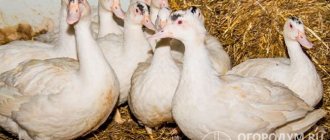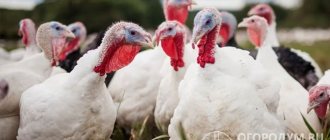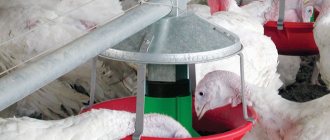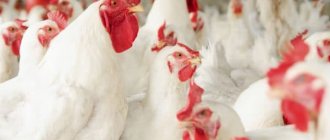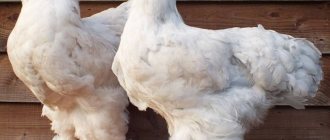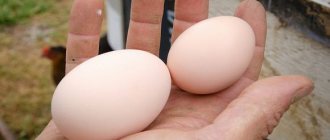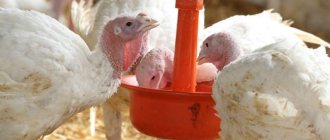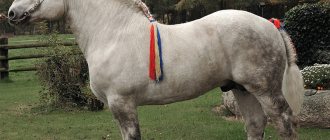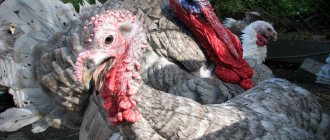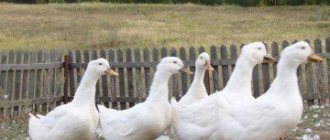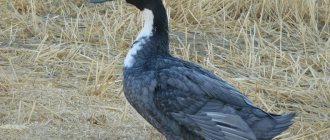- Features of keeping turkey poults
Raising turkeys at home is considered very promising, since the birds are unpretentious and large, and their meat has high taste and nutritional qualities. Even a beginner can handle most breeds. That is why interest in broiler varieties is growing at tremendous speed. Big 6 turkeys deserve special attention, which we will discuss in detail in the article.
The distinctive features of the bird are fast maturity and high vitality.
The main characteristics are given in the table:
| Parameter | Characteristic |
| Class | Birds |
| View | Turkeys (Meleagris gallopavo L.) |
| Breed/cross | "Big 6" |
| Productivity type | Meat |
| Feather and down color | White |
| Live weight at 16 weeks | Females – 10.4 kg, males – 14.4 kg |
| Meat yield from carcass | 78-80% |
| Feed conversion | Less than 2 (up to 10-14 weeks); 2.5-2.87 (at week 20) |
| Age of puberty | Starts at 5-6 months |
| Egg production | On average 10-110 pcs. per season |
| Egg fertilization | Up to 90% |
| Hatchability during incubation | 75-85% |
| Safety of young animals | On average 83-85% |
| Year of registration in the State Register of the Russian Federation | 2007 |
| Originator | British United Turkeys International Turkey Breeders |
Description and characteristics of the cross
Turkeys of the Big 6 breed are a fairly young cross, bred by English breeders relatively recently - in 2008. These heavy birds have successfully taken root in our country, falling in love with domestic breeders.
Description of appearance:
- thick, white, shiny plumage;
- small black spot on chest
- squat, massive body;
- small head;
- Long neck;
- wide, straight back;
- pronounced pectoral muscles;
- large wings;
- large, powerful paws.
Coral-colored skin folds are a distinctive feature of the breed. They are located in the area of the head and neck, descending vertically downwards. These bright red earrings and beard are some kind of indicator of the excellent health of the bird. No other turkey breed has such folds. These colorful decorations increase in size during arousal, reaching a length of 12-15 cm.
Big 6 turkeys are the heaviest farm birds. The weight of adult males is 20-24 kg, females – 10-12 kg.
This breed is very precocious, and at 3 months the chick already weighs about 4-5 kg, and by 5 months this weight doubles. Birds can be sent for slaughter at the age of 4 months.
By six months, the growth of birds almost completely stops, and further weight gain occurs mainly due to the accumulation of fat.
Growth chart for turkey poults (from 0 to 3 months):
| Age (in days) | Turkey weight (kg) | Turkey weight (kg) |
| 7 | 0.16 | 0.16 |
| 14 | 0.39 | 0.36 |
| 21 | 0.74 | 0.65 |
| 28 | 1.22 | 1.03 |
| 35 | 1.8 | 1.5 |
| 42 | 2.48 | 2.05 |
| 49 | 3.26 | 2.65 |
| 56 | 4.1 | 3.3 |
| 63 | 4.99 | 3.98 |
| 70 | 5.94 | 4.69 |
| 77 | 6.93 | 5.4 |
| 84 | 7.94 | 6.11 |
| 91 | 8.96 | 6.81 |
Productivity
Mature males gain up to 25 kg or more, and the average weight of turkeys rarely exceeds 12 kg. Already by the age of three months, birds reach a condition sufficient for slaughter, however, females are put under the knife 105-110 days from the moment of birth, and males - a month and a half later. This is explained by the fact that the intensive growth of muscle mass stops by this time, and further weight gain occurs due to the formation of excess fat deposits, which deteriorate the quality of meat.
The meat yield at slaughter is 80% of the total weight of the carcass, which is quite a lot. 30% of this volume is accounted for by the delicacy breast, which has a special dietary value.
Egg production of the cross is from 100 to 110 pcs. in year. In terms of beneficial and nutritional properties, the products are not inferior to chicken eggs, while turkey eggs are much larger in size. Each weight is from 70 to 80 g. Females begin laying eggs at the age of 7-9 months.
Breeding
Turkeys can be raised both on farms and in private farmsteads. Let's take a closer look at how to do this correctly, since Big 6 turkeys need special care, despite the fact that they are unpretentious in care.
Most breeders purchase turkey poults from hatcheries or poultry farms, but many prefer to raise them under brood hens and turkeys. The Big 6 breed is characterized by high hatchability of chicks, as well as low mortality.
Only healthy turkey poults are selected for breeding and must:
- have a well tucked in stomach;
- stand firmly on your feet;
- be active and mobile;
- have a scarred umbilical cord;
- have clean fluff near the anus.
Particular attention should be paid to preparing the premises for them. It should be well ventilated and disinfected before placing the chicks there. During the cold season, the room temperature should not fall below 20 degrees. When breeding turkeys at home, it is necessary to monitor the temperature.
In the poultry house, in the place of permanent residence of turkey poults, it should always be dry and warm (+30-35 degrees). As they grow older, the temperature should be lowered. This must be done gradually, since turkeys react negatively to sudden temperature fluctuations.
Which food to choose?
It is not advisable to overfeed turkeys, since Big 6 birds are prone to excess weight. In the morning and daytime, birds are fed wet mash, which should consist of grains. And the evening meal should include dry grain. To saturate the body with calcium and phosphorus, blood, fish and meat and bone meal are introduced into the birds’ diet. The fiber contained in straw and hay will help improve digestion. In summer, birds are fed grass.
Green feeds, sprouted grains and feeds of animal origin contain large quantities of vitamins A, E, B, H. The diet of turkeys must be balanced, containing all elements and vitamins, since if they are deficient, young animals are at risk of slowing growth, and adults can become victims reduction in egg production.
Raising and caring for adults
Big 6 is grown at home using a combination and cell method. Broiler turkeys are kept in a poultry house on deep litter, which must be changed several times a week.
The room should be equipped with a sufficient number of feeders with fresh food and drinking bowls with clean water. There should be separate containers with mineral supplements: shell rock and gravel, as well as ash and sand, so that birds can clean their feathers.
Turkeys require a lot of space, which should be taken into account when raising a Big 6 cross at home. Provide them with space; on average, one adult needs about 40 cm of free space. Allow them to walk outdoors in the summer. Equip them with comfortable perches in the form of wooden slats located 70 cm from the floor.
Feeding and maintenance
Representatives of the breed are quite demanding when it comes to their diet. One of the important conditions for the successful maintenance of Big 6 is complete, balanced and regular feeding. Big 6 crosses are fed the same feed as other turkey breeds. The only difference is their volume, since these birds are heavy and massive, and accordingly they eat more.
The main components of the diet of adult birds are:
- grain and legume foods (oats and buckwheat) – 65%;
- compound feed;
- chopped root vegetables (potatoes, carrots);
- corn;
- silage;
- green feed;
- straw;
- hay.
Some foods can be moisturized before feeding, for example, with whey or other fermented milk products. It is necessary to give green onion feathers (to improve appetite), and mix meal into food.
It is imperative to add vitamins for turkeys to the daily menu, which contribute to the full development of the bird, preventing the development of certain diseases.
Recipe
Every breeder may face such a problem as the lack of complete factory feed. In this case, you can prepare the feed mixture for broiler turkeys with your own hands. The easiest way, of course, is to simply mix various grain components, but you must remember that whole grains are poorly digestible. The most preferable option would be to grind it using a grain crusher.
To prepare homemade feed you should take:
- wheat – 30% of the total volume of the planned grain mixture;
- corn – 20% of the volume;
- soybean – 20%;
- premix (vitamin and mineral) – 0.15%;
- fishmeal – 10%;
- shell rock;
- ground eggshells.
You can mix chalk into the feed, but this should be done with caution.
If possible, it is better to exclude it from the prepared mixture altogether, since, having clumped into a lump, it can cause intestinal obstruction. It is important to maintain proportions and take into account that replacing one component with another may affect the productivity of the bird.
For example, replacing wheat with barley can not only stimulate rapid weight gain, but also provoke obesity in poultry.
Disease Prevention
Even under good living conditions, disease prevention must be done. At the same time, feeding with various drugs begins from the first day.
During the first 3 days, the chicks are given vitamin C by diluting 2 g of powder in 10 liters of ordinary water. From days 3 to 5, we replace vitamin C with drugs such as Intercox or Baycox (we give these drugs according to the instructions). For the next 3 days we give the livestock vitamin D3 (can be replaced with multivitamin complexes). From days 11 to 13, we feed turkey poults with copper sulfate (5 g of powder per 10 liters of water). On the 14th day, it is worth inviting a veterinarian who will give a vaccine against Newcastle disease.
From the 16th to the 21st day, experts recommend giving birds broad-spectrum antibiotics. If you don’t want to give medications for all 6 days, you can limit yourself to 3 days. On the 28th day we re-vaccinate against Newcastle disease. From the 30th to the 33rd day we give the birds a solution of copper sulfate. On day 37, we again add vitamin D3 to the diet. From 40 to 45 days we prevent mycoplasmosis. It is advisable to consult a specialist which drug is best to use. Today, according to reviews, thylan is a good drug. From day 50 to 55, we feed turkey poults with vitamin C.
It is advisable to draw this diagram in the form of a table, on which the intake of drugs will be noted by day, and hang it on the wall of the poultry house. As we carry out preventive actions, we cross off days on the calendar. This will help not to confuse anything.
Raising young animals
Day-old broiler chicks are kept in a brooder at a temperature of 30 degrees Celsius. As the turkeys grow, the temperature is gradually reduced. There is an opinion that turkeys love warmth and should be kept at high temperatures. But it is wrong. For fledged chicks, 20-25 degrees is required.
It is necessary to ensure that the temperature does not rise above 35 degrees. In the heat, turkeys grow poorly and can even die from overheating.
Grown-up turkey chicks are transferred to aviary housing. They are kept, like adult birds, on the floor. Chicks will need free range, which will help prevent problems with skeletal formation. Broiler turkeys grow very quickly, as a result of which their bones and ligaments do not have time to strengthen. Therefore, in order to raise healthy and strong offspring, it is necessary to provide the chicks with the longest possible walk. This measure will not protect your pets 100%, but at least it will significantly reduce the number of cripples in the population.
Feeding rules
Big 6 turkey poults need vitamins and plenty of protein food.
Chicks should be fed strictly according to the clock - this is the key to their successful development. The first 2 months are the most important in the life of turkey poults, so it is very important to provide them with a balanced, nutritious diet during this time.
Dairy products are important components of the diet.
During the first day, you should ensure that the chickens receive food every 3 hours. Give them liquid cereal porridge and boiled eggs. From the 4th day you can add wet, milk mash. On the seventh day, add vitamin D to the food.
In addition to starter feed, chicks over 10 days old can be given:
- wheat;
- barley;
- skim milk;• cottage cheese;
- grated carrots, beets;
- chopped green feed (alfalfa, dandelion, nettle);
- fish fat;
- green onions, which are a preventative against intestinal infections.
Provide turkey poults with constant access to water and feed, which should always be of high quality and fresh. Portions of food in feeders should be small, but at the same time acceptable so that the chicks are full.
As the young animals grow older, the number of feedings should be reduced. At the age of 2 months, turkeys can be fed 4 times a day.
Adult Big 6 dogs should be fed 3 times a day. You should not overfeed them, as birds have a tendency to become obese. Give turkeys wet grain mash in the morning and afternoon, and dry food in the evening.
Keeping turkey poults
In the first days of keeping turkey poults on the floor without a turkey, they may often bunch up, especially at night. As a result, the chicks can crush each other, which leads to their death.
Therefore, when raising more than 30 chickens at the same time, they should be placed overnight in boxes of 15-20 chickens per one.
Place them in a warm place, covering them from above, so that there is constant access to fresh air and they do not suffocate.
| Age of turkey poults, days | Air temperature, оС | Relative humidity, % |
| 1 — 3 | 31 — 30 | 74 — 72 |
| 4 — 5 | 29 — 28 | 72 — 70 |
| 6 — 10 | 27 — 24 | 70 — 64 |
| 11 — 20 | 24 — 23 | 64 — 62 |
| 21 — 30 | 22 — 21 | 62 — 60 |
From 4-5 days of age, turkey chicks begin to be released for walking, but only in warm, sunny weather. Until coral growths form on the necks of the chicks, which appear at approximately one month of age, the chicks do not tolerate dampness well. In view of this, you should not walk them outside in damp, rainy weather.
Temperature conditions
The main requirement when raising poultry is microclimate control. For the first 4 weeks, the chicks need to be kept in specially made compartments on the litter. For 7 days, it is important to maintain a temperature in the poultry house of 32-35 degrees, in the next 7 days, slightly reduce the heat level - 29-32 degrees, and the third decade should begin with a temperature of 27-29 degrees.
Daylight hours should be 12 hours, and in winter it is necessary to use artificial lighting. Birds are prohibited from high humidity and drafts.
Features of big 6 turkeys
Big 6 broiler turkeys are a very good cross for home breeding. They especially attract breeders with their precociousness, unpretentiousness in care and nutrition. Poultry eggs and turkey meat are also highly valued, surpassing in taste the much-loved chicken. Easily digestible fats, proteins and carbohydrates make it dietary. Phosphorus, zinc, potassium and magnesium in the composition help improve immunity. But broiler turkeys are valued not only for their tasty and nutritious meat, but also for their high-quality, very light and soft down and feathers.
The bird belongs to the group of heavy lines, which gains weight very quickly. A feature of the breed is that turkeys stop growing after 100 days of age, so there is no need to feed them for a long time.
Turkeys are raised on average for 110-115 days, and male turkeys - 140-150 days. Keeping them longer is not profitable, and therefore makes no sense, since they will no longer grow.
Big 6 turkeys have a good meat yield, up to 80% of the total body weight. Of these, 30% comes from brisket, which is a very respectable figure.
Productivity
Due to their high productivity, these birds are suitable for both large-scale breeding and small private farms.
Meat yield
For turkeys, the average percentage of finished product yield is about 60-65% of the total body weight. Live weight depends on the category to which the bird belongs. There are three such weight groups:
- Easy. This includes birds whose weight does not exceed 9 kg for males and 5 kg for females. This subspecies is slightly smaller than the main specimen, but can be kept in cages.
- Average. Turkeys in this category weigh up to 17 kg, turkeys - about 7 kg. Suitable for garden plots, mainly for pen keeping.
- Heavy. Large birds, the weight of males reaches 23-26 kg, females - from 11 to 13 kg. Despite its large mass, it is the fastest ripening. Young animals reach maximum weight already at 10-12 months of life.
Egg production
Big 6 turkeys are not known for their abundance of clutches. On average, one female produces 100-110 eggs per season. The laying period lasts from 6 to 9 months. The weight of each egg is much larger than the chicken eggs we are used to; the minimum weight is 85 grams. The shell is hard and difficult to break, has a yellow-beige color with small specks. The yolks are thick and viscous, often containing two or more in one egg.
Maternal instinct
Turkeys are very sensitive and attentive mothers. With the beginning of the egg-laying period, they try to sit on the clutch. The hatching rate of chicks during natural incubation is even higher than when using an incubator. Attentive hens do not leave the clutch, so they need to be given food and water directly to the nest (otherwise they will lose weight). How many days does a turkey sit on eggs? Read in this material.
After the hatching of the offspring, the mother can become aggressive, as she instinctively takes care of the brood. However, it is recommended to remove young animals from turkeys and keep them separate from the main stock.
Egg production
An ideal turkey family consists of 1 male and 6-8 females. Turkeys are valued not for their weight, but for their excellent egg production. On average, one mature female can lay about 105-110 eggs per season.
They begin to lay eggs at the age of 7-9 months. Big 6 turkeys are excellent hens that hatch their clutch very conscientiously.
It is possible to increase the egg production of females by artificially lengthening the daylight hours. This is done using fluorescent lamps. Also, for turkeys, if possible, special half-trap nests should be equipped, from which the hen can get out, but other turkeys will not be able to get in.
Productivity
Heavy crosses have high productivity, and the hybrid is no exception in this regard. During turkey slaughter, the meat yield is about 85%. A third of this volume falls on the bird's breast. An adult bird gains its body weight in 150 days; after this time, its flesh is filled with vitamins and macroelements. Turkey meat products have no allergic components, they are low in fat, but have high juiciness.
In terms of eggs, the female's productivity is approximately 80 eggs per year. With intensive nutrition, egg production can increase to 150 eggs. The average weight of one egg is 80 grams, they are characterized by the correct shape, density and smoothness of the shell. The taste of this product is excellent; they can be consumed both raw and after heat treatment. The survival rate of chicks reaches at least 85%.
Diseases
The Big 6 turkey breed may be susceptible to the following diseases:
- Newcastle disease (incurable) – causes mass mortality. Symptoms: paralysis of the lower extremities, gray-green-yellow diarrhea.
- Histomoniasis (liver disease in turkeys). Caused by parasitic protozoa. The common name is “poor maintenance disease.” Signs: extreme thirst, foamy, green-yellow stool, loss of appetite, weakness, trembling, drowsiness, feathers ruffled and dirty in color.
- Mycoplasmosis. With timely treatment, the mortality of birds is minimal. Symptoms: puffy eyelids, cough, wheezing, poor growth.
- Aspergillotoxicosis - develops from birds eating low-quality food or keeping them on a dirty floor. The disease manifests itself in turkeys by inactivity, drowsiness, rapid breathing and poor appetite.

